What's New
Displaying results 3581 - 3590 of 4052

Resource | Fact Sheets,
The UNAIDS/WHO Working Group on Global HIV/AIDS and STI Surveillance, initiated in November 1996, is the coordination and implementation mechanism for UNAIDS and WHO to compile and improve the quality of data needed for informed decisionmaking and planning at national, regional and global levels.
The Epidemiological Fact Sheets are one of the products of close collaboration around the globe. The Fact Sheets collate the most recent country-specific data on HIV prevalence and incidence, together with information on behaviour determined to be important in understanding the epidemic.
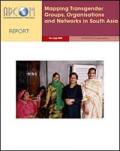
Resource | Publications,
Technical and funding support based on such evidence for large scale strategic interventions that address male-to-male and transgender sexualities and related HIV vulnerabilities is only now beginning to materialize in South Asia. One of the first steps needed in scaling up this response is to map the populations concerned and their representative groups, organizations and networks. This study was commissioned by APCOM and carried out by SAATHII, and aimed to map the situation of and HIV 'infrastructure' for transgenders in the South Asian countries of Afghanistan, Bangladesh, Bhutan, India, Maldives, Nepal, Pakistan and Sri Lanka.
The mapping study focused on transgenders, given that not enough is known about their specific vulnerabilities to HIV and the response that is already under way to address these vulnerabilities.
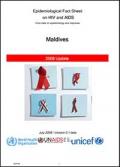
Resource | Fact Sheets,
Global surveillance of HIV, AIDS and sexually transmitted infections (STIs) is a joint effort of UNAIDS and WHO. The UNAIDS/WHO Working Group on Global HIV/AIDS and STI Surveillance, initiated in November 1996, is the coordination and implementation mechanism for UNAIDS and WHO to compile and improve the quality of data needed for informed decision-making and planning at national, regional and global levels.
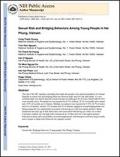
Resource | Publications,
The risk of the HIV epidemic spreading from high-risk groups to the general population in Vietnam depends on sexual risk and bridging behaviors between high- and low-risk individuals. A crosssectional study was used to describe sexual activities of youth aged 18–29 years. Nearly half (41.4%) were sexually active. Premarital sex was reported by 43.3% of them; 78.3% of sexually active males and 13.5% of sexually active females. Multiple sex partners were reported by 31.0%; 56.7% of males and 9.2% of females. Almost 27% of males and 5% of females engaged in sexual bridging behaviors. Being unmarried was significantly associated with having sex with non-regular partners. Being unmarried and early age at first intercourse were associated with having sex with a sex worker. Consistent condom use was high with commercial sex workers but low with regular partners. Education to delay early sexual debut, increased employment, and strategies to inform young sexually active people to adopt safer behaviors are urgently needed.
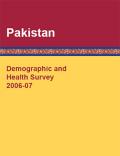
Resource | Publications,
The 2006-07 Pakistan Demographic and Health Survey (PDHS) is the largest household-based survey ever conducted in Pakistan. Teams visited 972 sample points across Pakistan and collected data from a nationally representative sample of over 95,000 households. Such a large sample size was required to measure the maternal mortality ratio at the national level. In fact, this is the first survey that provides direct estimates of the maternal mortality ratio at the national level.
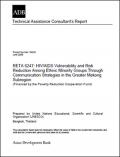
Resource | Publications,
ADB Regional Technical Assistance (RETA 6247) was financed by the Poverty Reduction Cooperation Fund from the United Kingdom's Department for International Development, with parallel financing from UNESCO. This RETA 6247 was, in part, a continuation of the previous RETA (RETA 6083, ICT and Preventive Education in the Cross-border Areas of the Greater Mekong Sub-region). However, it also built and expanded on the lessons identified from the previous project. The earlier RETA, jointly carried out by the Asian Development Bank (ADB), UNESCO and SEAMEO, was implemented during the period April 2003 to September 2004. Under it, ADB/UNESCO pioneered the use of linguistically and culturally appropriate materials in the form of radio soap operas (dramas) for transmitting HIV/AIDS, drug and trafficking prevention information to highly vulnerable ethnic minority populations often living in remote areas in the Greater Mekong Sub-region (GMS). It further established the use of Geographic Information Systems (GIS) for mapping, tracking and monitoring the spread of HIV/AIDS in Thailand, as well initiating the UNESCO-based Clearing House (CH) on Preventive HIV/AIDS education in the GMS.
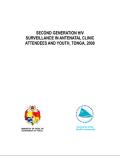
Resource | Publications,
Tonga is a small island nation comprising 169 islands with four main island groups with a population of 101, 991 people. Two-thirds of the population resides on the main island of Tongatapu with 23% residing in urban areas. HIV prevalence in Tonga is very low with no HIV cases detected in antenatal women in the previous Second Generation Surveillance (SGS) survey conducted in 2004. In 2008, Tonga conducted a second round SGS in antenatal women and youth population groups.
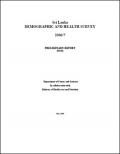
Resource | Publications,
The objective of this report is to publish the preliminary findings of the Sri Lanka Demographic and Health Survey (SLDHS) until the release of the Final Report which will carry detailed information. The preliminary findings reported here are confined to Background characteristics of respondents such as current fertility, current use of contraception, fertility preferences, maternal care, vaccination coverage, treatment for childhood illnesses, breastfeeding, nutrition, awareness of HIV/AIDS and prevention and it is expected that this will satisfy the urgent needs of users.
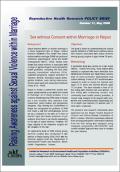
Resource | Fact Sheets,
Sexual violence within or outside marriage is a much neglected topic in Nepal. Limited research elsewhere has shown that sexual violence within marriage (SVM) has profound emotional, psychological, social and health consequences. The study is aimed at understanding the cultural specific definition of SVM and to examine nature and reasons associated with sexual violence among young couples of ages below 28 years.

Resource | Publications,
Pakistan currently has very low levels of human immunodeficiency virus (HIV) infection; the overall HIV prevalence rate is less than 0.1 percent in the general population. However, the country is considered to be at high potential risk for an HIV epidemic for a number of reasons. In particular, in the major cities there are large concentrations of individuals engaging in behaviors that make them vulnerable to the rapid spread of HIV and of classical sexually transmitted infections (STIs). The infection can spread to the general population through the bridging population, who are individuals who have contact both with high-risk groups and the general population. The bridging population can be defined by prevalence data of STIs, including HIV, if known, or by the identification of risk behaviors.
This study of urban men commissioned by the National AIDS Control Program, with funding from Department for International Development (DFID) (United Kingdom), is one of the three studies originally designed to measure reproductive tract infection (RTI) and STI prevalence and sexual behaviors in the high-risk groups, in men comprising the intermediate-risk group, and in women representing the low-risk groups.





